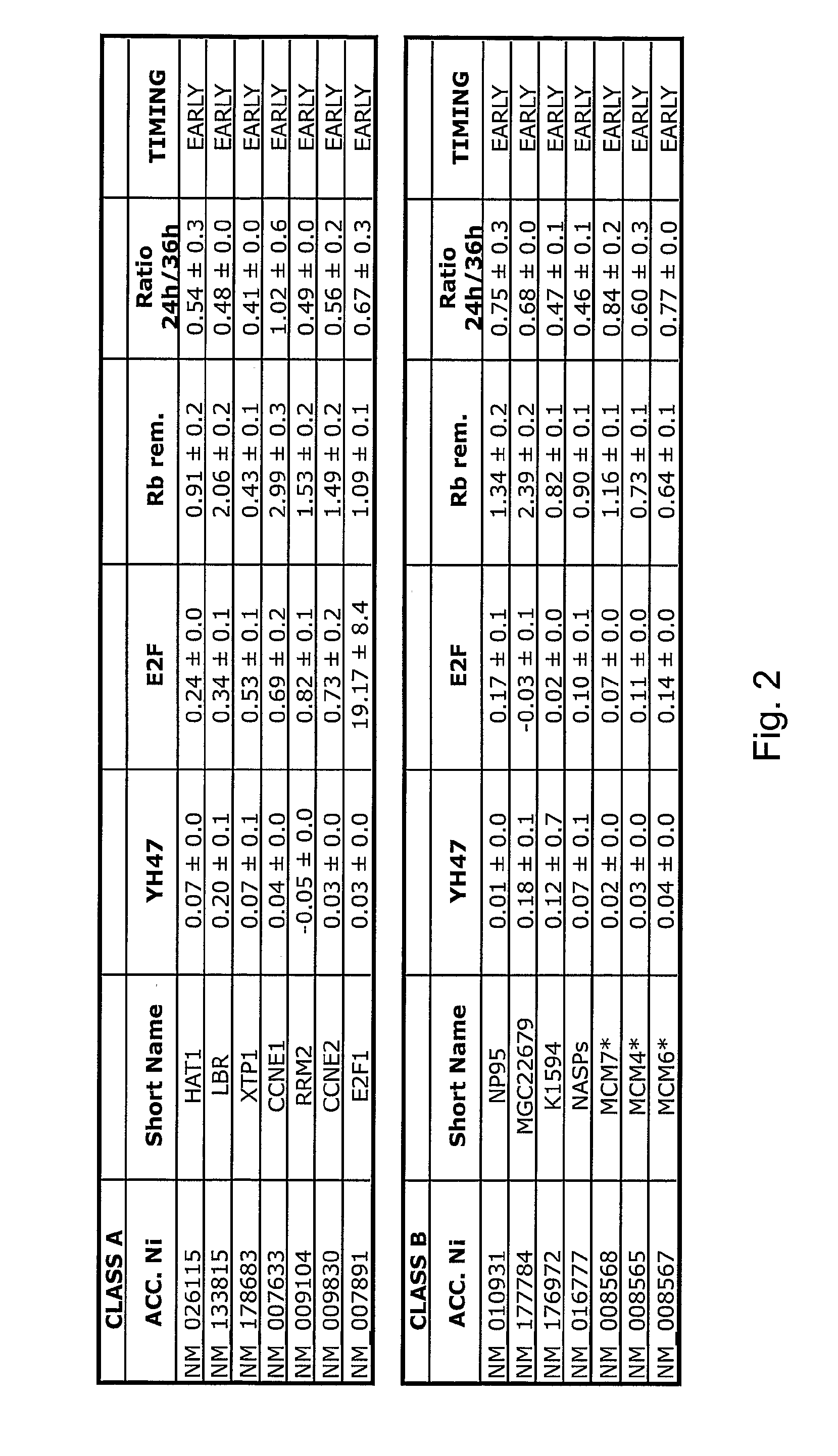Cancer markers
a cancer and marker technology, applied in the field of new markers, can solve the problems of not being able to provide good results from datasets, not being able to readily allocate to particular molecular pathways, and not being able to provide high-quality signatures in the prior art, and achieve good indicators
- Summary
- Abstract
- Description
- Claims
- Application Information
AI Technical Summary
Benefits of technology
Problems solved by technology
Method used
Image
Examples
example 1
[0247]We used a cDNA subtraction approach to clone genes whose expression is induced by E1A, concomitantly to its induction of re-entry in the cell cycle of TD myotubes.
[0248]TD C2C12 myotubes were infected with either the adenovirus dl520 (expressing only the 12S mRNA of E1A) or the control adenovirus dl312 (expressing no E1A mRNA). Only the dl520 infected myotubes displayed 48 h p.i. S-phase re-entry phenotype (about 70%). 2 μg of time course pooled polyA+ RNA from dl520 and dl312 infected myotubes was used as starting material for cDNA retro-transcription (Invitrogen) and subtraction procedures (Clonetech) to obtain a library of about 800 clones.
[0249]E1A induced library was screened by Reverse Northern. 14 filters (7 plates, 2 filter per plate) contained all the cloned sequences as single purified PCR bands and some controls (DNA ladder IX as negative control, adenoviral cDNA and NP95 sequence as positive control, GAPDH as internal standard). Each plate (2 filters) was hybridize...
example 2
[0257]E1A exerts pleiotropic effects on TD myotubes. It suppresses tissue-specific genes, through its binding to the transcriptional co-activators p300 / CBP and MyoD, and reactivates the cell cycle, through a mechanism in which binding to pocket proteins (mainly pRb and p130) and restoration of E2F activity is pivotal. However, the ectopic expression of E2Fs in TD myotubes does not induce S phase, indicating that other E1A-activated pathways are concomitantly needed. Indeed E1A-regulated pocket / Rb-independent mechanisms are known, which involve CycE / CDK2-, CtBP-, TRAPP- or p400-regulated pathways, and other chromatin remodelling activities. While it is unclear how these activities contribute to the creation of a S-phase environment, there is evidence that some of these pocket / E2F-independent pathways contribute to E1A-mediated oncogenesis. In keeping with our initial strategy, we tried therefore to classify the E1A-induced genes according to their upstream mechanism of regulation.
[02...
example 3
[0268]We directly tested this possibility by in situ hybridisation on tissue microarrays (TMA) containing hundreds of tumour samples derived from ten different tumours, along with their matched normal counterparts. Fifteen E1A-induced genes were tested, including representatives from all classes. Strikingly all the six class D genes were overexpressed in a significant fraction of cancers, when compared to normal matched tissues (FIG. 3a). In addition, there was no significant correlation between the tumour proliferative index (as assessed by immunostaining with anti-Ki-67) and the levels of four of six class D genes (SKIN, TRPC4AP, SMU-1 and ch-TOG / KIAA0097), indicating that the overexpression event is not the consequence of the tumour hyperproliferative state (not shown).
[0269]This contention was further supported by the finding that four of six class D genes (SKIN, DDX21, TRPC4AP and SMU-1) did not behave as cell-cycle regulated genes, while all the Class-A and class-B genes were ...
PUM
| Property | Measurement | Unit |
|---|---|---|
| time | aaaaa | aaaaa |
| diameter | aaaaa | aaaaa |
| time | aaaaa | aaaaa |
Abstract
Description
Claims
Application Information
 Login to View More
Login to View More - R&D
- Intellectual Property
- Life Sciences
- Materials
- Tech Scout
- Unparalleled Data Quality
- Higher Quality Content
- 60% Fewer Hallucinations
Browse by: Latest US Patents, China's latest patents, Technical Efficacy Thesaurus, Application Domain, Technology Topic, Popular Technical Reports.
© 2025 PatSnap. All rights reserved.Legal|Privacy policy|Modern Slavery Act Transparency Statement|Sitemap|About US| Contact US: help@patsnap.com



